But Lexus found it a long time ago. The IS sedan, presented three years ago, came out with a hybrid version from the very first moment, and neither has nor will have diesel engines. In fact, the hybrid version is the heart of the range, the only alternative will be a turbocharged 2.0 that replaces the previous 2.5 naturally aspirated V6. The IS 300h has four cylinders, which doesn't seem very premium, but the important thing is the result, and it can easily pass for a V6. The electric motor provides unrivalled refinement with cylinders.
Mechanically the formula is very convincing, but in terms of design it is noted that we are not facing a German car, more consolidated aesthetic solutions, and appeals more to taste. In other words, or like it, or not like it, but does not leave indifferent. The version tested, F Sport, has a markedly more macabre image, as wanting to like a more radical audience, but the truth is that it is facade. What's more, I'm afraid that the type of customer who values such an overloaded design won't be able to afford it for a long time.
Design
For many years Lexus designs were very bland and lacking in punch, something quite normal if we take into account the average age of the customers they were aimed at. Little by little the designs have been improved, but they are starting to cross the lines of good taste. The F Sport version, in my humble opinion (as despicable as anyone else's), is very overdone, and the lower half of the front grille is just too much. The idea of separating the light clusters in two pieces, the headlight itself and the daytime running lights in the shape of an arrow, doesn't seem right either. The fog lights are LEDs.
On the other hand, when people gave me their opinion about the car, I had the impression of driving a luxury car, although the connoisseurs had no idea what the brand was. It looks much more elegant when viewed from the side, with the waistline connecting the headlights, or with the curve that rises from the bottom of the B-pillar to the boot lid spoiler. The Lexus arrow motif is all over the place, sometimes perhaps a bit too much.
It feels a bit out of proportion. Look at the side view, the wheels look smaller than they are, they're 18 inches, with 225/40 tyres at the front and 255/35 at the rear. You can also see that the disc brakes look too small for the overall package. It's not that it's poorly equipped with brakes, it's just that the hybrid system makes it unnecessary to carry something bigger, but that's the visual sensation. The access version, ECO, has 17-inch wheels.
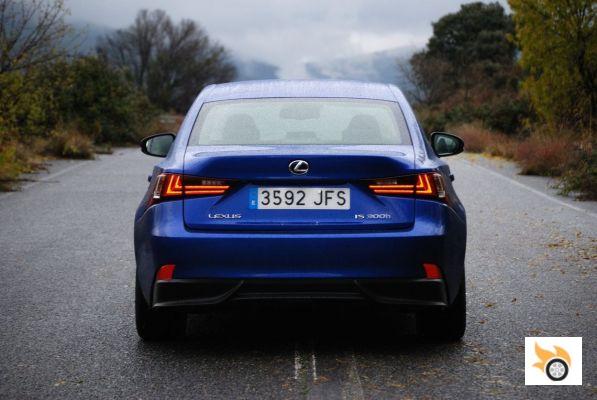
If you look at the rear, you'll wonder where the exhaust pipe is. It's deliberately hidden on the F Sport, and on the rest of the IS 300h. It really does have an exhaust, but it's like a low-displacement diesel - it's hidden there, as if with a complex. The aerodynamic diffuser is a bit overdone, I don't consider it necessary. At least it no longer has the feeling of such a high, boxy rear window as the previous generation IS had. In that sense, the design has improved.
Both the front and rear light clusters are embossed with three-dimensional detailing that's easy to see up close.
Anyone who wants something different from what the three German premium monarchies have to offer is certainly in for a treat. This car is more eye-catching than the triad of the 3 Series, A4 and C-Class. But the Jaguar XE also offers something different, and the design is much more beautiful and proportioned. Lexus designers are looking for provocation with the current range, that much is clear. A comment on the tailgate: it's hard to find the button to open it, and when it goes up it can bounce a bit. This is a bit annoying in a car that costs more than 45,000 euros.
The version analysed is not exactly the same as the one launched in 2013, as it received some changes. The side hybrid badge is twice as big, in tune with the NX 300h. This is the only way we can tell it apart. As for the F Sport version itself, it gets more aggressive bumpers and different alloy wheels. Visually I find any other version more elegant. By the way, the front fog lights are LED, current models also have those fog lights on non-F Sport versions (they used to be halogen).
Cabin
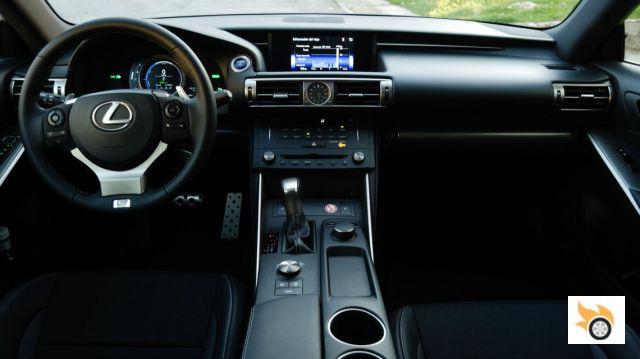
Once inside, the interior seems to be designed with a very Japanese philosophy: modernity and tradition in almost equal parts. In terms of design, I think it lacks coherence and harmony, it seems to be made by different people depending on the area, but with little communication between them. The F Sport version has a distinctive badge on the steering wheel, aluminum pedals, a dominant black color and a specific dashboard.
On 2015 models they've changed different interior materials, only the trained eye will notice, and improved the view of the reversing camera. The rest of the IS has a classic dashboard, with four needle dials and a central digital display. The IS 300h F Sport has all digital instrumentation, with an actual silver dial that shifts to the center or right depending on the chosen layout. It's a detail that, without knowing why, ends up pleasing.
Not only does the layout of the elements change, but also the ambience. It can have a more hybrid behavior, with a potentiometer, or sporty, with an aesthetic similar to the LFA and the simulation of needles. At first the dashboard can be overwhelming, especially for the "senior" over 50. For a digital native it's virtually no mystery, it's possible to quickly adapt to its menus and different modes.
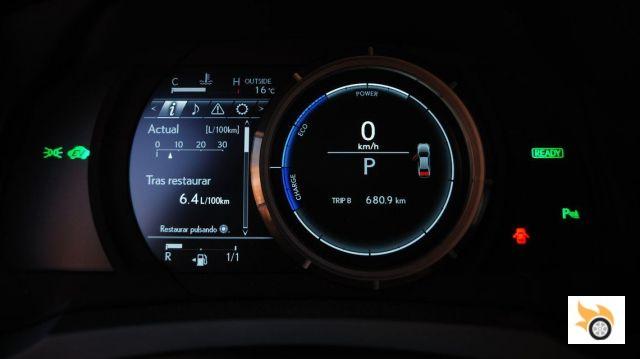
As with any Lexus, there are more buttons than necessary, and they're scattered throughout the cabin. We're not talking about the base model, and there are three custom button slots at the driver's left knee. This is very useful for James Bond, but not for the normal user. I would have preferred a small glovebox with a lid, like many cars in this segment.
Let's move to the middle area, where there is a contrast between the leather upholstery on the top and the poor looking plastics in the area between the two seats. I see little functional coherence. The upper display seems smaller than it really is, the climate control temperature controls can be confusing the first few days. Instead of using conventional buttons they have resorted to ones that mimic a mobile phone touch surface.
The heated seat controls take up too much space, it's very poorly used. The F Sport has heating, but the Luxury also adds ventilation. That gear lever, for goodness sake, is totally unnecessary. In a car like this, which doesn't really have gears, the Jaguar solution, a rotary shifter, fits perfectly. For "shifting" there are the paddle shifters on the steering wheel. It wastes a lot of space this way. Also, the lever allows - which it shouldn't - to switch off the engine without being in "P" position.
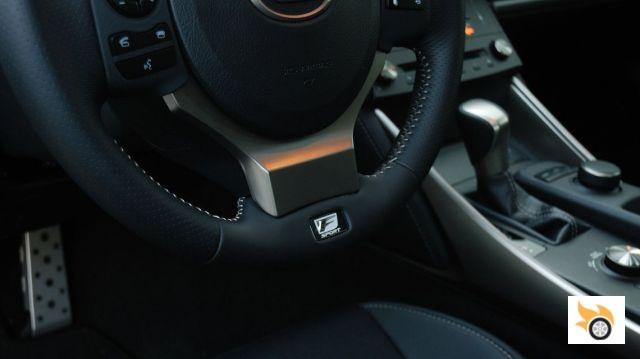
Behind the lever there's a wheel that modifies the behavior of the hybrid system, mainly the throttle sensitivity. In the case of the F Sport, the suspension is of variable hardness, and can be stiffer in the sportier mode, although the difference is not very marked. The stability control can only be switched off when stationary and after waiting several seconds. On the move only allows you to disconnect the traction control. The snow mode allows a smoother start on difficult surfaces.
Just to the right of it, there's a space that can hold a small or medium-sized mobile phone, and further on, the roulette that controls the multimedia system and the upper screen. The handling takes a lot of getting used to, sometimes it's too sensitive, it lacks the quality of adjustment of Audi's MMI, Mercedes' COMAND or BMW's iDrive. With these three systems I'm much faster. The buttons at the front are not always visible, sometimes we will be tempted to look at them while driving, and that's already a design mistake.
The cup holders are too far back, especially uncomfortable for the co-driver.
Under the driver's armrest there's a recess with a cover, where there are two USB, an auxiliary socket and a cigarette lighter socket. For those of us who charge our mobile phones on the move, there are a couple of well thought out plastic guides, so that the cable can be held in place, and when the lid is lowered it won't be damaged. The space in the glove compartment is not very big. The glove compartment doesn't have room for many things if the manuals and the reflective vest go in it. If the space was better used, we could empty more pockets.
Let me comment on the seats. In the F Sport version the front seats have a sportier character, and it's very easy to find a good driving position. What's more, we'll go a little lower than normal, a nod towards driving pleasure. The available headroom is fine for most drivers, but if you're about 1.90 metres tall, you might want to consider whether or not to have the sunroof. It has a detail that I really appreciate, the steering wheel partially collaborates to the entry and exit, a detail worthy of higher segments.
In the rear there is more legroom than in the previous model. The 80 mm that the car has grown in length is mainly noticeable in the wheelbase, which has grown by 70 mm, as well as the space for rear passengers. To begin with, the car has to be considered as a four-seater in which, occasionally, a child or a very thin person can sit in the middle seat, and who is not tall. It is enough to look at the photos to feel pain, seeing how the seat belt anchorages are positioned. The occupant on the left can be bothered by the buckle intended for the central passenger.
The side seats are correct up to 1.8 meters high, but you have to be careful with your head when getting out of the car.
In addition, the central rear seat has a headrest that doesn't go up very high, a small table that makes the backrest very hard, and a very bulky central tunnel. Three adults are going to be uncomfortable. If there are only two, the side contours of the seats will leave a very good impression. Unfolding the central table there are two hidden cup holders. There are no other storage spaces. Between the front seats there are air vents, but the temperature can not be regulated, something that an Audi A4 does allow, optionally.
The car in terms of comfort is very well resolved. The engine makes virtually no noise, and aerodynamically you can go surprisingly fast without noticing discomfort. There are no creaks, no crickets, all the elements form a unit, like the Power Rangers. The main source of noise comes from the tyres, especially on the rear axle, as the tyres are wider. It's relatively easy for passengers to fall asleep.
The car gives a great feeling of isolation, especially with the Mark Levinson hi-fi sound system, purposely designed for this car, which allows you to enjoy music in a different way... without paying a huge premium, which would happen in its rivals. We will have more the impression of traveling in a car of the E segment, or hurrying, in one of the F, except for the space. This car is not recommended for those who fall asleep at legal speeds.
As for the trunk, as it usually happens in the sedans of this category, it does not stand out for spaciousness, nor for capacity, nor for the regularity of its forms. The hybrid version has 450 liters, the IS 200t goes up to 480 liters, the average of its competitors. Under the floor we will find a puncture repair kit and very basic tools. Unlike the previous generation, the rear seats can be folded down asymmetrically, except in the IS 300h ECO, where this is not possible.
Technology
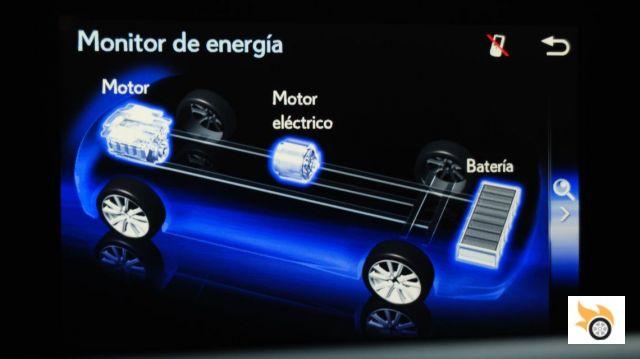
The most interesting thing about the car is the hybrid system. Like all Lexus, the engine is arranged longitudinally and sends the power to the rear wheels. There are exceptions, the CTs are front-wheel drive, non-hybrid versions of the IS can be all-wheel drive - but not in our market - and the LS 600h is hybrid and all-wheel drive as standard. The main engine is the 2AR-FSE, a 2.5-liter four-cylinder inherited from the Camry Hybrid, which puts out 181 hp at 6,000 rpm. A less powerful 155 hp version is available for the NX 300h and RAV4 Hybrid, codenamed 2AR-FXE. Although the unit capacity per cylinder is large, it is a fairly refined engine, which is hardly noticeable when starting, and not at all when it is switched off.
Complementing the petrol engine is a 143 bhp synchronous electric motor, although it is limited to 65 bhp by the power output of the nickel-metal hydride (NiMh) batteries. These batteries are located in the trunk, are air-cooled, and compared to lithium batteries are cheaper, but heavier and bulkier. The combined power is 223 hp, although the driver will always subjectively perceive that the car is less powerful than it should be.
Accelerates to 100 km/h in 8.4 seconds, and does not exceed 200 km/h.
The automatic transmission, which behaves like a CVT, is a planetary gearbox with epicyclic gears. In Christian, heat engine and electric motor are engaged in a clutchless gear system, so that they can push individually or separately. It is a pure hybrid, so the electric motor can push the car with the petrol engine switched off, up to almost 80 km/h. At higher speeds, the petrol engine is always engaged, even if its consumption is zero, to protect the engine generator from excessive rotation. It is possible to go as slow as you want, very useful for parking.
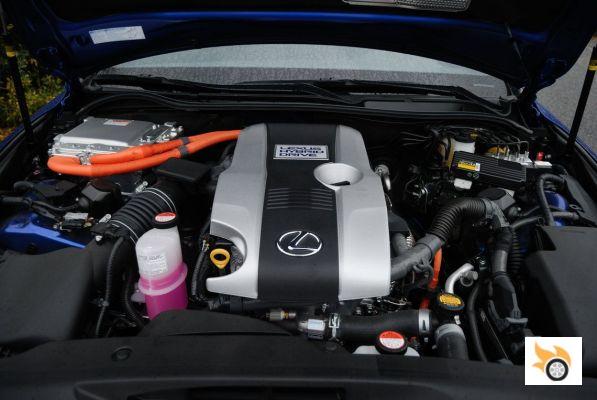
This car, like any hybrid, recovers energy from deceleration, braking or with the excess power of the petrol engine. The 2AG-FSE has Toyota's dual injection system, with four indirect and four direct injectors, combining the best of each injection system. Operating on the Atkinson cycle, the engine has low specific power, but makes better use of the gasoline's energy. Its thermal efficiency is very similar to that of the 1NZ-FXE in the Prius, almost 40%. The capped 155 hp engine has differences internally, it has less compression and is less reinforced.
The transmission will make sure the petrol engine works as efficiently as possible, even if that means generating more power than necessary and converting it into electricity. In urban areas and driving smoothly on extra-urban routes, at low speeds, is where the advantage over any car with a thermal engine is most noticeable. If the green "EV" light is illuminated, it means that the petrol engine is not doing anything. The driver can force the "zero emission" mode, only with electric motor, but it can be counterproductive. It's better to let the car do the work.
The Toyota/Lexus hybrid system has three major drawbacks. First there's the weight, then there's the driving feel compared to a normal car, and the sensitivity of the system to temperature changes. If it were fitted as standard with flaps that shut off the airflow to the radiator, efficiency could be improved by 10% or more. Keep in mind that the engine is overcooled for normal driving conditions. However, the heating works faster than in a Prius or CT 200h, as this engine heats up faster.
Driving
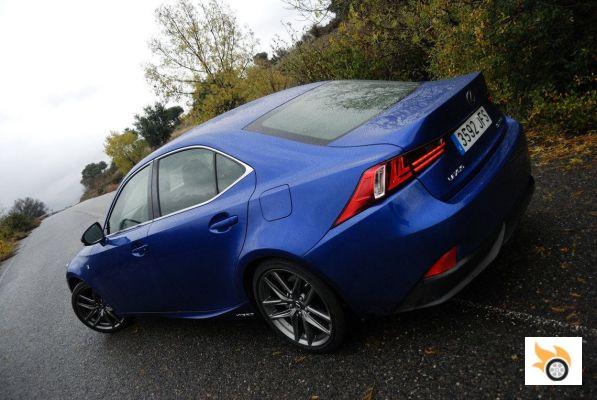
The IS 300h drives like any automatic car, but we have to consider that it doesn't actually have gears. The planetary gearing ensures that the petrol engine turns as little as possible, unless there is a high demand for power. There is no direct relationship between engine speed and revs, as there is in other cars on the market. The petrol engine tends to rev at a static speed, and the gear ratio is varied, hence it mimics a CVT.
Subjectively, if you've never driven a hybrid, you'll have the feeling that the clutch has broken - it doesn't have one - and that it won't stop slipping. But the speed goes up, and it goes up well, with tremendous progressiveness. Sinking the accelerator pedal at 80 km / h we will have a recovery to 120 km / h of less than 6 seconds. It's not the fastest in the segment, but it's not slow at all. Keeping the accelerator pedal depressed long enough can make us fall into a radar.
The suspension is a bit hard to contain the whole, which is a bit heavy.
The power is concealed by a kerb weight of 1.8 tonnes and the particularities of the transmission. The electric motor can provide instantaneous power, but the petrol engine needs a few tenths of a second to rev up and push. In the city, on the other hand, the car will seem like a rocket leaving from a standstill. Above 100 km / h that feeling is conspicuous by its absence. The ideal in urban areas is to start from a standstill with the electric motor, accelerating gently, and then allow the petrol engine to act.
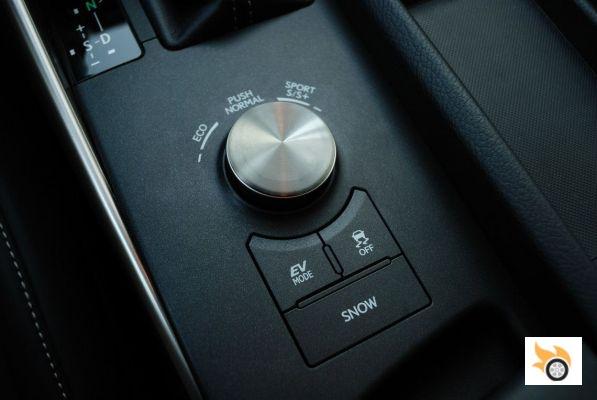
In pure electric mode you can do a couple of kilometres on the flat, but with a perfect knowledge of the terrain you can do a few more, inserting the neutral point of the transmission. Unlike a normal car, it does not pose the slightest safety problem. In this car all the auxiliary groups are electric, they do not depend on the engine speed, in fact there is no service belt. The distribution is by means of a maintenance-free chain. This mechanical solution is extremely reliable.
It has a pseudo-sequential mode that mainly serves to control the retention of the petrol engine. The main use is to descend mountain passes. Under any other use we will have the feeling of playing Playstation, a tremendously artificial sensation. The reality is that the overwhelming majority of IS 300h users will barely use this functionality. That's why I think a conventional gear lever is redundant.
Except in ECO mode, there's a function called ASC, which is intended to simulate the sound of the IS F's 5.0 V8. As the petrol engine makes hardly any noise, it's a way to get a more car-like feel, simulating gear jumps and exhaust gurgles, as long as your ears aren't too critical. Accelerating hard the sounds overlap, and the feeling of falseness is maximum, because they do not agree with each other. This sound is never loud, but you can mute it if you want. It would have to be louder to camouflage the sound of the real engine.
The smooth feel of the hybrid system is at its best, like the most refined of V-engines, but with no noise. The engine is only minimally annoying at full throttle, when it has to rev, and the silence that prevails in all other situations is lost. When you roll down the windows, the engine makes a very nice sound, the exhaust is more insipid than a glass of water.
All these characteristics are going to be appreciated more by a man with his grey hair or baldness, than by a younger one. Although the car sells aggressiveness, it is more grateful with the anticipated, efficient and relaxed driving. If we want strong sensations, we're going to have to ask a lot of the car, because it's too civilized to be a rear-wheel drive. They've made it that way with every intention.
With the stability control on, the car doesn't let anything get out of control, as long as the tyres have grip. It's a real line-driver, it goes where you ask it to go, and at the limit it's more understeery. The rear axle is extremely restrained. Disconnecting the aids, to achieve a nice skid you have to ask for it please, and play with the weight transfer. Ideal for those who are afraid of propulsion, they will forget what they are driving.
With the Sport+ mode on, you'll notice the steering is more precise and less power-assisted, and the suspension less leaky. In addition, the accelerator pedal is very sensitive, and can feel more powerful than it really is. On the other hand, in ECO mode, the accelerator pedal responds very little to prevent the car from consuming more than it should. The behaviour of the pedal to the floor is exactly the same, the available power is always the same.
When cornering at the limit it becomes clear that the car is a bit heavy, and that it is preventing us from being evil. If you're looking for more radical handling, you're looking at the wrong car. The IS 300h brings, above all, safety. In this brand even the IS F is too civilized unless we know how to look for the tickle and touch the buttons to disconnect aids. The Japanese philosophy is like that, let's not give it any more thought.
The brakes work well, but metering requires a bit of training. The initial part of the pedal causes the electric motor to hold, the disc brakes don't really do anything, and that's why they last so long. It's only when you push harder that they kick in. If the IS 300h driver is serious about early braking, the pads last a long time, which helps save money.
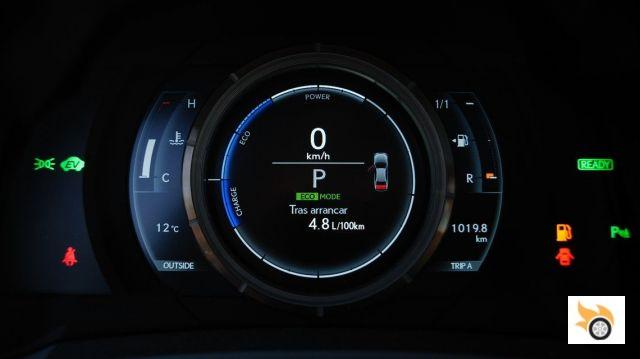
Let's talk about fuel consumption, another very interesting part. With a full tank of gas, I was moving around my usual routes, almost always respecting the speed limits and driving in a similar way as a "senior" would. I'm used to driving hybrids and I drive it more smoothly than someone who has never owned such a car. The consumption was not intended to be the minimum possible, but a realistic one. It was used when any comfort features had to be used, including heated seats.
After 680.9 kilometres, I filled the tank to the top again, taking 46.37 litres. The actual average was 6.8 l/100 km, the computer read 6.4 l/100 km. The tank of this car is large, 66 liters, so you can do almost 1,000 kilometers per tank. In the second part of the test I took three more adults and went on a long trip to check the impact compared to driving alone and unladen. In running order we are already talking about 2 tons.
With a good flow it spends less than 6 l/100 km without doing anything dangerous, and in traffic jams the consumption doesn't go up, on the contrary: it goes down!
At 850 km it went into reserve, with an additional range of 55 km. As with all Toyota and Lexus cars, the range shown is always less than what the car can actually do. In fact, I kept pushing it to 900 km, when the range was only 11 km, and I didn't want to push it any further. The real average was similar, 6.8 l/100 km. If you know the route and you drive it well, it has a very stable consumption. The minimum I got in a partial was 4.8 l/100 km according to the computer, and downhill. The homologation is too optimistic, 4.6 l/100 km with this particular version.
Conclusions
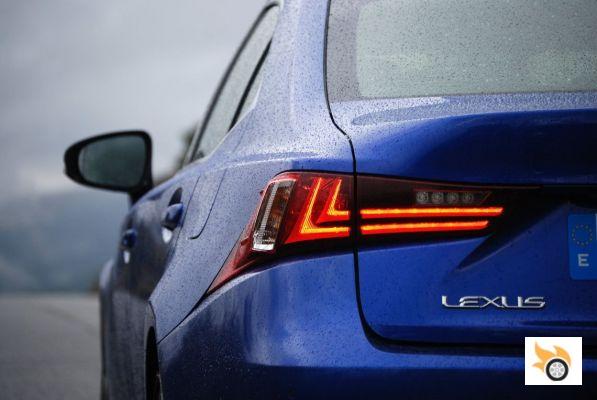
In total, I drove 1,747 km with this car, and it was hard to get rid of it. Although I still think like a 30 year old, in the long run I know I'd get on better with it. I know a diesel can spend less, but not get me around with the same driving pleasure, and this one holds up for less money. There's no clutch, no turbocharger, no particulate filter, no belts... and the brake pads and tyres last a bit longer than normal. The formula can be improved, especially by lowering the weight and using more rational tyres than those used in the F Sport.
The concept of a sporty hybrid, I'm sorry, doesn't quite fit, and I'm not convinced. It's more like an executive car, with the non F Sport image, and travel like a gentleman. For the carbonillas are the IS F, much more expensive, and with a thirsty and powerful V8. This hybrid, to be truly sporty, needs a number of considerable changes. Strip away the artificial sound, refine the planetary gear algorithm (even if it wastes more) and fit the right exhaust line, and it could pass for a naturally aspirated L6. But the IS 300h customer isn't looking for that.
Anyone who doesn't want to jump through the diesel hoops to spend little should look at this model. Lexus hybrids, unlike those of its rivals, are not so prohibitively expensive, nor so focused on high performance. If you don't want a hybrid, you can go for the turbocharged IS 200t, or look for a used IS 250 with a 2.5 V6 natural intake. The "pure" petrols have a torque converter gearbox. The driving feel is much more... natural. But in the long run, you learn to love the hybrid, and get used to its advantages.
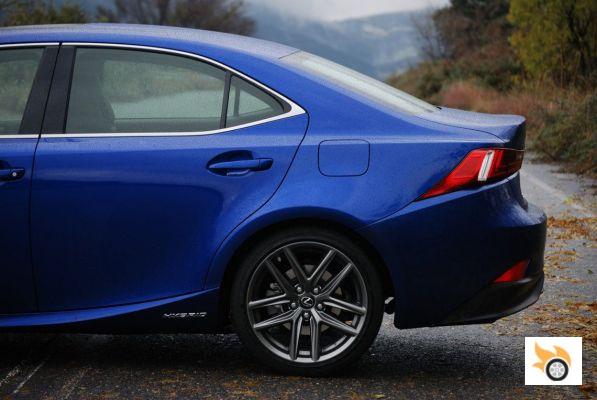
The tested version costs 47,500 euros, or 49,050 euros if we take into account the navigation system. As is usually the case with Lexus, the range is structured in closed levels, as in a generalist manufacturer. The IS 300h ECO is available for 35,900 euros, and the most luxurious, the Luxury, for 53,400 euros. Adding the additional safety systems, we stand at 56,600 euros. Its European rivals are much more flexible in this respect, and although the IS will give you more equipment for the same price, you'll also pay for a lot of things you don't want. But Lexus' equipment policy is like that, and you have to love it as it is.

























